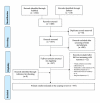Use of Telehealth During the COVID-19 Pandemic: Scoping Review
- PMID: 33147166
- PMCID: PMC7710390
- DOI: 10.2196/24087
Use of Telehealth During the COVID-19 Pandemic: Scoping Review
Abstract
Background: With over 37.8 million cases and over 1 million deaths worldwide, the COVID-19 pandemic has created a societal and economic upheaval of unparalleled magnitude. A positive transformation has been brought about by innovative solutions in the health care sector that aim to mitigate the impact of COVID-19 on human health. For instance, the use of telehealth has been on the rise amidst this public health emergency.
Objective: Given the unprecedented scale of the pandemic with no definitive endpoint, we aimed to scope the existing telehealth-related literature during a defined period of the ongoing pandemic (ie, January to June 2020).
Methods: Our scoping review was guided by the Joanna Briggs Institute Reviewer Manual. We systematically searched PubMed and Embase databases with specific eligibility criteria. Data extracted from the shortlisted articles included first author and affiliation, journal title, publication type, terminologies used to describe telehealth and their accompanying definitions, health discipline or medical specialties and subspecialties wherein telehealth had been applied, the purpose of telehealth use, and the authors' overall sentiment on telehealth use. We collated the available information and used descriptive statistics to analyze the synthesized data.
Results: In all, 543 articles published across 331 different journals were included in this scoping review. The Journal of Medical Internet Research and its sister journals featured the highest number of articles (25/543, 4.6%). Nearly all (533/543, 98.2%) articles were in English. The majority of the articles were opinions, commentaries, and perspectives (333/543, 61.3%). Most authors of the articles reviewed were from high-income countries (470/543, 86.6%), especially from the United States of America (237/543, 43.6%). In all, 39 different definitions were used to describe terms equivalent to telehealth. A small percentage (42/543, 7.7%) of the articles focused on the provision of COVID-19-related care. Moreover, 49.7% (270/543) of the articles primarily focused on the provision of multiple components of clinical care, and 23% (125/543) of the articles focused on various specialties and subspecialties of internal medicine. For a vast majority (461/543, 84.9%) of the articles, the authors expressed a celebratory sentiment about the use of telehealth.
Conclusions: This review identified considerable emerging literature on telehealth during the first six months of the COVID-19 pandemic, albeit mostly from high-income countries. There is compelling evidence to suggest that telehealth may have a significant effect on advancing health care in the future. However, the feasibility and application of telehealth in resource-limited settings and low- and middle-income countries must be established to avail its potential and transform health care for the world's population. Given the rapidity with which telehealth is advancing, a global consensus on definitions, boundaries, protocols, monitoring, evaluation, and data privacy is urgently needed.
Keywords: COVID-19; scoping review; telehealth; telemedicine.
©Sathyanarayanan Doraiswamy, Amit Abraham, Ravinder Mamtani, Sohaila Cheema. Originally published in the Journal of Medical Internet Research (http://www.jmir.org), 01.12.2020.
Conflict of interest statement
Conflicts of Interest: None declared.
Figures



References
-
- WHO Coronavirus Disease (COVID-19) Dashboard. World Health Organization. [2020-11-23]. https://covid19.who.int.
-
- Baig A, Hall B, Jenkins P, Lamarre E, McCarthy B. The COVID-19 recovery will be digital: a plan for the first 90 days. McKinsey Digital. 2020. May 14, [2020-11-23]. https://www.mckinsey.com/business-functions/mckinsey-digital/our-insight....
-
- Strehle EM, Shabde N. One hundred years of telemedicine: does this new technology have a place in paediatrics? Arch Dis Child. 2006 Dec;91(12):956–9. doi: 10.1136/adc.2006.099622. http://europepmc.org/abstract/MED/17119071 - DOI - PMC - PubMed
-
- A health telematics policy - in support of WHO's Health-for-all strategy for global health development. Report of the WHO Group Consultation on Health Telematics, 11-16 December, Geneva, 1997. World Health Organization. [2020-11-23]. https://apps.who.int/iris/bitstream/handle/10665/63857/WHO_DGO_98.1.pdf?....
Publication types
MeSH terms
LinkOut - more resources
Full Text Sources
Medical

